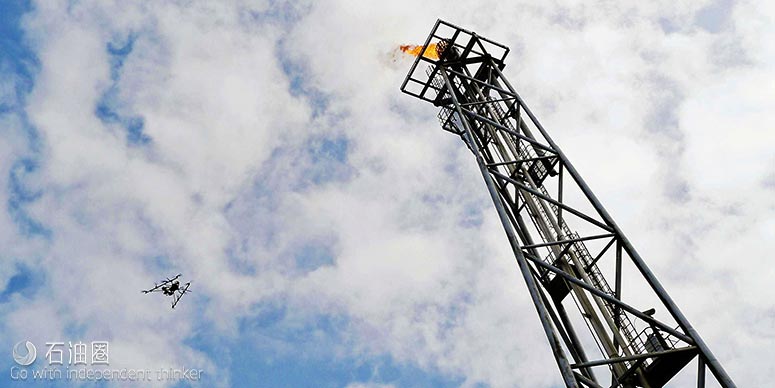The offshore industry has been quick to embrace unmanned aerial vehicles (UAVs), or drones, for visual inspection tasks. The technology ticks a lot of boxes in these costconscious times — they are fast, inexpensive, and require far fewer people on deck and in transit. They improve safety while delivering better data, users say. Maersk Oil recognised the advantages of UAVs early on and made them part of its offshore inspection operations in 2013. “You could say we were early adopters of the technology,” says Mark Fotheringham, director of facilities and projects in the company’s UK business. “The market was quite limited for drones at that time.”
Drones provided a practical alternative to the type of inspections required at Maersk Oil’s North Sea installations, including the floating production, storage and offloading (FPSO) units Gryphon, at the Gryphon, Maclure and Tullich fields, and Global Producer 3, which handles production from the Dumbarton, Balloch and Lochranza fields. Regulations require periodic inspection of hard-to-access areas such as flare towers and the insides of storage tanks. That once meant the time-consuming process of erecting scaffolding to enable inspections or, for some challenging areas, hiring rope access crews.
Rope inspection, when practical, is a popular option because it requires fewer people and less time than scaffolding, and allows better access to confined spaces or difficult-toreach areas. UAVs take these advantages a step further, Fotheringham says.
“Ropes were a major step forward”, he says. “Drones are another major step forward” in reducing time and personnel. “Drone inspection is essentially a one or two-man show.”
Two-pronged approach
Two years ago, at Gryphon, UK company Cyberhawk Innovations conducted what it claimed to be the first inspection of a cargo oil tank on an operational FPSO (Upstream Technology 04/2016).
The procedure took less than a day and involved a two-person team consisting of an UAV pilot an inspection engineer.
“We have throughout worked closely with the drone company and have developed a great relationship where we innovate together, come up with new ideas, develop and test the technology,” says Fotheringham.
“Prior to the tank inspection we made several technical adjustments and tests of the drone, and these allowed us to fly the drone within the tank to take the video and pictures we needed.”
Maersk Oil has since extended the drone inspection programme to the 26 cargo tanks on the Gryphon and Global Producer 3 platforms. The technique gives a good general inspection — cameras, Fotheringham points out, have vastly improved since the early days of drones.
However, more detailed inspection requires closer, prolonged contact. But not necessarily human contact — in what the company says is another first, Maersk Oil is planning a more detailed tank inspection that will supplement drone surveys with a “crawler” device equipped with lights, highdefinition cameras and other equipment.
The crawler will be guided along the vertical walls of the tank, taking measurements of the steel plates and stiffeners with an ultrasonic probe. Inspectors will use the information to check for corrosion and, if found, to plan remediation efforts.
“We will use the crawler to look at anomalous indications and make a close visual inspection,” Fotheringham says.
Crawlers and drones each have advantages. Flight gives the latter more freedom of movement. But crawlers get power from electrical leads, not batteries, which means they can be equipped with powerful lights and deployed for longer stretches.
“With drones, you’re running on batteries,” he says. “So to support that many lights you’d be flying back pretty often.”
Maersk Oil has used a drone to inspect a flare tip at the Tyra East gas field in the Danish sector of the North Sea, an operation that previously required a helicopter with a photographer on board.
The drone was able to get much closer to the flare tip and was able to gather more detailed visual information, Fotheringham says.
The company has worked with DNV GL for verification of its drone inspections. DNV GL and other classification societies are “very much on board with the technology”, he says. “They see the benefits, and have been very supportive.”
Wider use
Maersk Oil has launched a new project involving drone technology that will create detailed 3D maps of its offshore assets, similar to the satellite images used by online map services such as Google.
The maps will be used for a number of tasks — when engineers are devising lifting plans, for example — but will be especially handy for “dropped objects” inspections after an installation is hit by one of the North Sea’s punishing storms, Fotheringham says.
“Before, we would send a crew out to do a survey after adverse weather,” he says. Soon, a drone will be deployed after a storm to conduct a survey.
The data will be compared with the 3D maps to spot any anomalies that could indicate damage and warrant closer inspection. As technology uptake increases, the offshore industry will find new ways to put drones to work in the service of efficiency and safety.
“The more you use a technology, the more uses you find for it,” Fotheringham says. A drone could be useful during offloading operations, he notes, ferrying documentation between the FPSO and the cargo vessel, for example, or it could take the messenger line over from the FPSO to start offloading operations.
As drones become more integral to daily operations, he says, it is possible that offshore crews will soon include a drone pilot. “Right now we use specialist crews. But I could see one day having a trained, dedicated drone pilot on board the offshore installation.”
A drone could also be useful as a first responder in an accident or a key element of search-andrescue operations, he adds.
Demand will drive UAV manufacturers to address the technology’s current limitations, boosting battery and payload capacity.
And as offshore operators seek ways to automate tasks, reduce on site personnel and reduce safety risks, rising demand for drones looks like a safe bet.

 石油圈
石油圈
